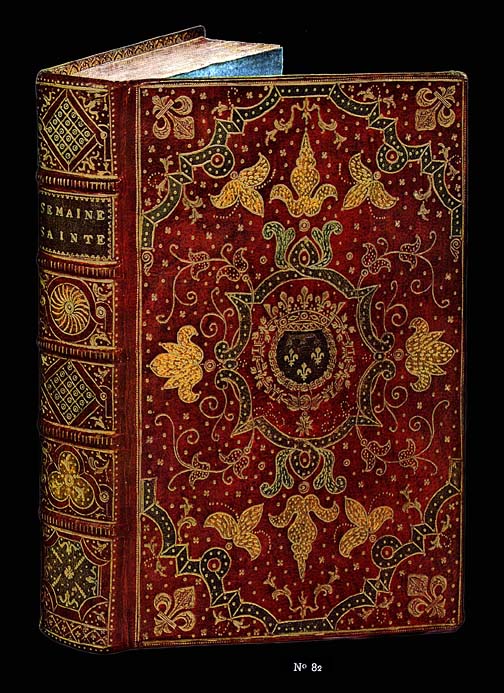


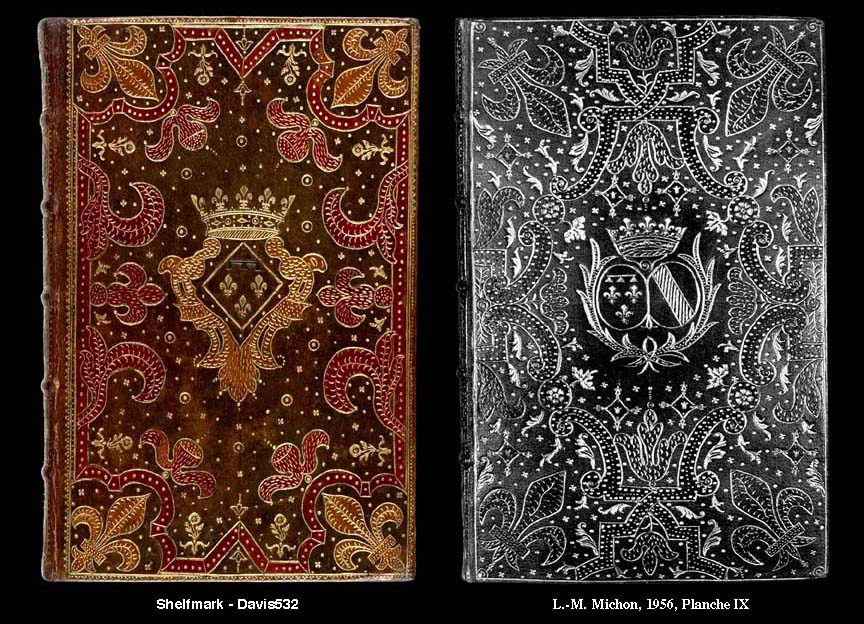
| As we observed on the preceding page there is some question as to the identity of the binder of British Library specimen, Davis532. In the database details for this item, the reader is informed that: this binding may be by Duseuil or Padeloup. On this present page I hope to outline some of the basic issues concerning its attribution to Augustin Duseuil as opposed to my conclusions of the previous page where I have demonstrated that many of the Davis532 tool imprints are identical to those found on bindings hitherto attributed to Padeloup. At the top of the page I have reproduced item No.82 from the 1972 Catalogue of the renowned Bibliophile and expert, Raphaël Esmerian, as well as the accompanying text. Roughly translated the lower part of this text reads: |
|
"Superb mosaic binding from the 18th Century, featuring the Arms of Philippe II, Duke of Orléans. Executed admirably, with a marvelous composition reminiscent of the Regent's copy of Daphnis et Chloe, now in the possession of the Baron F. de Rothschild, this binding is the work of Augustin Duseuil and is from his most creative period. We know of three mosaic Semaine Sainte bindings made by Duseuil for the Regent, all of the same date, 1716: the one described here, a second with the arms of one of his Daughters, and a third with the arms of his wife, Mlle de Blois, noted by Quentin-Bauchard in the Library of the Baron James de Rothschild. This binding (No.82) is found in the inventory of L.-M. Michon, Les reliures mosaïquées du XVIIIeme siècle, 1956, p.71. No 147." |
|
Unfortunately I do not have this work by Michon, however I did manage to acquire a copy of his Planche IX which is marked "7. DUSEUIL." I have reproduced this above next to the Davis532 example which according to the British Library data is an L'office de la Semaine Sainte published Paris 1716 , Ownership mark: Louise Adelaide, Mademoiselle of Orleans, Reference Notes: Louise Adelaide was the daughter of Philippe II, Duke of Orleans. Thus I think that this must be the second binding to which Esmerian was referring, and that the Michon Plate IX may be the third. All three bindings contain imprints from the same tools, tools which by all previous assessment, derive from the Atelier of Padeloup le Jeune. To shed some further light on this question, I now refer the reader to the work of Thoinan (see further Thoinan details), who gives a very detailed biographic account of Duseuil and his work. This author, who was certainly one of the foremost authorities of his time, boldly states that he does not know of a single example that can be verified as the work of Duseuil. Below I reproduce the relevant paragraph of Thoinan's text... |

|
...however the entire page is well worth reading (click here to see the full page)( and here to see the following page). One year after the publication of Thoinan's book (1893), Herbert P. Horne published a work entitled The Binding of Books, An Essay in the History of Gold-Tooled Bindings, in which we find abridged translations of Thoinan's work. I reproduce below part of Horne's text, which obviously derives from Thoinan. This concerns the first part of Duseuil's career and his nomination as Royal binder in the year 1717. This nomination came about due to the insistence of the Duchess of Barry, who through the influence of her father the Duke of Orléans managed to establish a precedent of three Royal binders. |
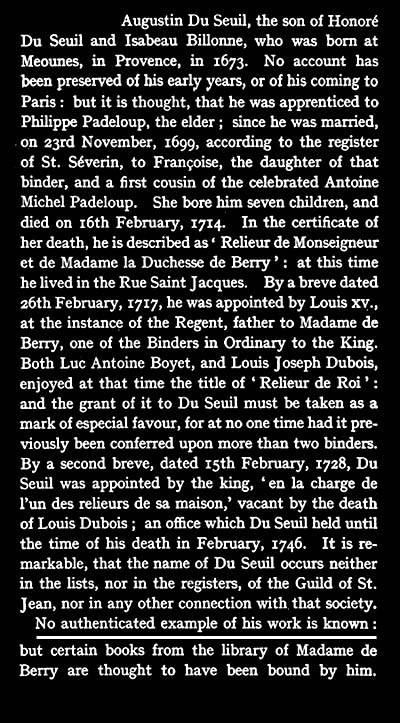
| Below is a copy of part of the text of Duseuil's Royal brevet granted by the King Louis XV |

| Not being well versed in French History, I decided to try some of these names with Google and quickly discovered some interesting details in the Wikipedia, details that both Thoinan and Horne omitted to tell us: firstly we find that Louis XV, was born February 15, 1710; he became the King when he was only five years old. This means that he was barely seven years old when he signed Duseuil's brevet! |
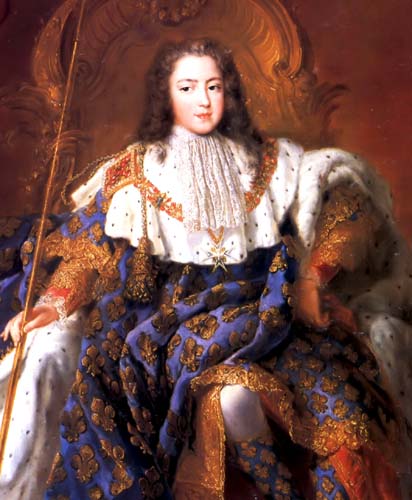
| Second is that, Philippe II, Duke of Orléans, Philippe Charles (August 2, 1674-December 23, 1723) called Duke of Chartres (1674-1701), and then Duke of Orléans (1701-1723) was Regent of France from 1715 to 1723. His regency during the minority of Louis XV being the last regency in the kingdom of France, he is still commonly referred to as le Régent and his regency as la Régence. On the death of Louis XIV (September 1, 1715), the late king's five-year-old great-grandson was crowned king Louis XV of France. The duke of Orléans went to the parlement, had the will annulled, and himself invested with absolute power, and the then forty-one-year-old Philippe became Regent. |
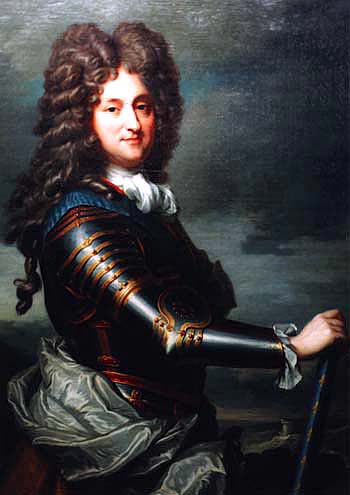
|
Thus we see that the Duseuil's nomination by Louis XV was only a matter of form and in fact was actually a decision made by the Regent at the request of his daughter. "The Regent had great qualities, both brilliant and solid, which were spoilt by an excessive taste for pleasure. His dissolute manners found many imitators, and the regency was one of the most corrupt periods in French history." "Philippe was a professed atheist who boasted to read the satirical works of François Rabelais inside a Bible binding during mass, and liked to hold orgies even on religious high holidays. He acted in plays of Molière and Racine, composed an opera, and was a gifted painter and engraver. Despite his atheism, Philippe favoured the Jansenists against the decrees of the Pope." "He was a great collector of art, and his collection of paintings, mostly sold in London after the Revolution, was one of the finest ever assembled." |
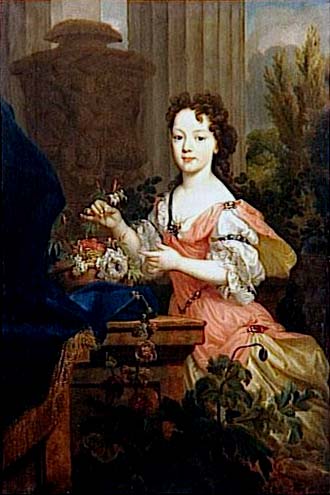
|
Next we must examine the life of the Duchess of Berry. In searching the internet it was not long before I found Joan's Royalty in History site where we find a fairly extensive biography of Marie Louise of Orléans (1695-1719). "At the age of 6, Marie Louise became so ill that the physicians gave up on her. Eventually they even thought that she was dead. In despair, her father threw out the quacks and personally nursed his little girl back to health. From then on he spoiled her tremendously. At the age of 14, Marie Louise had her own little court of ladies at the Palais-Royal. At the same time, her ambitious mother was already scheming to arrange a marriage for her with the 23-year-old Prince Charles (1686-1714), Duke of Berry." "The Duke of Saint-Simon, wrote about Marie Louise: "Her arrogance bordered on folly, and she was capable of the lewdest indecencies. [..] She did all she could to make M. the Duke of Berry, who was genuinely pious and completely honest, give up religion. [..] She lost no time in having affairs, which were conducted so indiscreetly that he soon found out about them. Her daily and interminable sessions with M. the Duke of Orléans, where it was clear that he [Berry] was not wanted, put him in a rage. [..] At each of the many informal meals she took, she became dead drunk, and threw up whatever she had eaten". "Then, on April 26, 1714, Charles fell from his horse, while he was out hunting. He expired on May 4. Marie Louise had become a widow at the age of 18." I should here point out again a detail mentioned in Duseuil's biography, which is that his wife also died in the year 1714 (on the 16th of February), and that on her certificate of death, it was noted that Duseuil worked as a binder for Monseigneur et de Madame la Duchesse de Berry. Duseuil would have been over 40 and by this coincidence shared a common bond with the Duchess as a widower. However as he was of a distinctly different social class it would be difficult to imagine that he was anything more to the Duchess than a humble relieur and faithful servent. On the other hand, what a stroke of good fortune for Duseuil to have fallen in with the most powerful family in France. In any case we now know that three years later the Duchess asked her father, who was then the Regent, to have Duseuil made a Royal Binder. This would appear to have been but a small favor to ask, a trifle I should think for the Duke who was in the habit of granting his daughter's every wish. All of which points to Duseuil as a very likely candidate when it comes to speculating about the bindings of books that were owned by the Duchess or her father, and it is not at all difficult to imagine how these mosaic bindings, bearing the arms of the Duke and his family, have come to be attributed to him. However, we must not fail to take into account the fact that the Regent was a self-proclaimed atheist. How then do these three, 1716 Office de la Semaine Sainte publications in presentation bindings, fit into this picture? One can hardly imagine an athiest rushing out to buy books of prayer for his whole family, let alone going to the expense of having them lavishly bound in decorative bindings. I am tempted to speculate that someone else, a third party, may have offered these specially bound copies as gifts to the Regent and his family. Consider these facts: Padeloup signed a good part of his work and many of his bindings are known. These three bindings can be shown to resemble certain other Padeloup bindings wherein we find identical tool imprints. Duseuil never signed any of his work, and there is not a single binding known that can be certified as being his work. Thus we do not have the slightest idea of what Duseuil's bindings might have looked like. On the other hand what is fairly certain is that he is reputed to have bound many books in his lifetime. If even a few of these were mosaics (other than the three that are in question here) we should today certainly be able to point to some other examples, or work by Duseuil that could at least demonstrate some evidence of similarity. However this is not the case and therefore I submit that we are truly clutching at straws to imagine that Duseuil was the author of these classic mosaic bindings. |
| Go to Digital Alchemy | return to the home page of cyclopaedia.org |